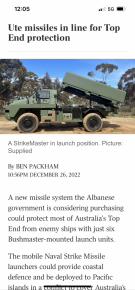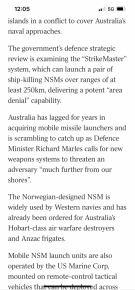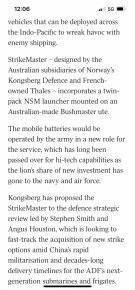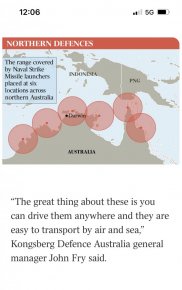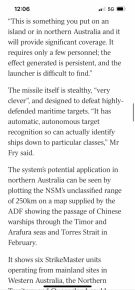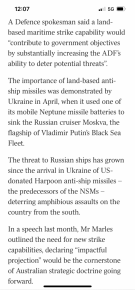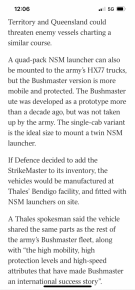Redlands18
Well-Known Member
This reminds me of the British aiming all the heavy artillery in Singapore seaward, in early 1942, because they were expecting a Sea Borne invasion, so the Japanese come overland. The problem though, is that the Strikemaster is only effective out to 270k, any vessels will also be carrying missiles with that sort of range or better and the NSM is only effective against surface targets, does nothing for the Air or Sub-surface threat and unless you support them with AD and ground forces, they will be extremely vulnerable against incoming missiles and SF Teams.The rest of the article. Cut a few lines short but you get the gist …View attachment 49982View attachment 49982
View attachment 49982View attachment 49983View attachment 49984View attachment 49985
Any AShM capability is going to need to be supported by other ADF elements, when deployed.
While the role on mainland Australia would be limited they would have a useful role in protecting sea lanes for deployed forces, Also I dont think they will be under such a large threat when deployed domestically. Sure a fixed installation an enemy will know exactly where it is but these are mobile so they need to track them down. These if acquired IMO aren't so much as a front line weapon to hold our coasts but rather a supporting asset for deployed forces, allied nations and under the very worst and least likeliest scenario a last step option to prevent enemy vessels landing and invasion force.This reminds me of the British aiming all the heavy artillery in Singapore seaward, in early 1942, because they were expecting a Sea Borne invasion, so the Japanese come overland. The problem though, is that the Strikemaster is only effective out to 270k, any vessels will also be carrying missiles with that sort of range or better and the NSM is only effective against surface targets, does nothing for the Air or Sub-surface threat and unless you support them with AD and ground forces, they will be extremely vulnerable against incoming missiles and SF Teams.
Any AShM capability is going to need to be supported by other ADF elements, when deployed.
Todjaeger
Potstirrer
Something to keep in mind about long-ranged AShM is that some sort of surveillance system or systems are needed in order to detect the would-be targets, ID them as targets, and then relay that data to decision makers and then ultimately the missile launchers, with everything happening rapidly enough for the data to be useful. IMO that is one of the great problems as well as biggest potential weaknesses of such systems. If the system cueing the launchers is neutralized some how, then the launchers themselves being effectively useless unless/until they are able to detect targets on their own.While the role on mainland Australia would be limited they would have a useful role in protecting sea lanes for deployed forces, Also I dont think they will be under such a large threat when deployed domestically. Sure a fixed installation an enemy will know exactly where it is but these are mobile so they need to track them down. These if acquired IMO aren't so much as a front line weapon to hold our coasts but rather a supporting asset for deployed forces, allied nations and under the very worst and least likeliest scenario a last step option to prevent enemy vessels landing and invasion force.
buffy9
Well-Known Member
I don't believe the LBASM capability is intended to defend North Australia. Modern cruise missiles (i.e. CJ-10, >1,500km) launched from subs, escorts and bombers overcome the range of the NSM, so any fixed infrastructure is ultimately engageable while a carrier group intending to conduct a major strike is still likely to be well escorted, meaning a dispersed NSM capability has to punch through a lot of layers before it threatens the COG - assuming it is dispersed. Not to mention the kill-chain to get a firing solution in the first place.Article extracted from the Australian about the strike master with NSM. What do the pros think of the claim that 6 units could defend Northern Australia? View attachment 49978View attachment 49979View attachment 49980View attachment 49981
I suspect the concept is more to have a sub-unit or two that can be placed on islands or around straits. Ground vehicles in complex terrain will be difficult to remove, like a splinter, but nonetheless shape and (in theory) deter a force's action - with the ability to respond if necessary. It imposes cost and is something Australia can do at a relatively low cost (assymetry).
I like the StrikeMaster, it seems good, but proper assessment is probably for the better rather than letting media run the tender process. The platform for the LBASM hasn't been chosen and there are alternative ideas out there - HIMARS with LRASM or PrSM offers more punch and mobility even if more risky; whereas Typhon offers a lot of flexibility, even if much less mobile.
Last edited:
NSM on a ute............................Why not!Something to keep in mind about long-ranged AShM is that some sort of surveillance system or systems are needed in order to detect the would-be targets, ID them as targets, and then relay that data to decision makers and then ultimately the missile launchers, with everything happening rapidly enough for the data to be useful. IMO that is one of the great problems as well as biggest potential weaknesses of such systems. If the system cueing the launchers is neutralized some how, then the launchers themselves being effectively useless unless/until they are able to detect targets on their own.
A useful addition to the ADF kit bag.
Does it need support and have limitations .............sure thing.
But what doesn't.
It's an investment worth looking at that provides another layer of deterrence and complexity for the bad guy.
In relative defence terms not that great an expense in capital and personnel.
A mobile land / air portable ASM system for a maritime nation occupying a massive island surrounded by vast oceans dotted with thousands of islands.
Should of had such a capability decades ago.
Cheers S
Here’s a quick and very simplistic 6x range rings overlaid on northern Australia.NSM on a ute............................Why not!
A useful addition to the ADF kit bag.
Does it need support and have limitations .............sure thing.
But what doesn't.
It's an investment worth looking at that provides another layer of deterrence and complexity for the bad guy.
In relative defence terms not that a great an expense in capital and personnel.
A mobile land / air portable ASM system for a maritime nation occupying a massive island surrounded by vast oceans dotted with thousands of islands.
Should of had such a capability decades ago.
Cheers S
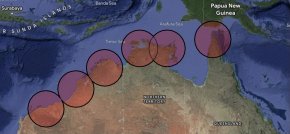
You’re not altogether denying any bodies of water near Australia (except maybe the Torres Strait / Gulf of Carpentaria) but it would certainly make life very difficult for anyone trying to land or sustain forces in Northern Australia. As if that wasn’t hard enough.
That said, if you replaced NSM with LRASM-SL, and made those range rings 40% bigger, you’d be able to add significant complexity for anyone trying to use Sunda / Lombok (from Christmas Is) or approach Micronesia (from Manus).
Not against a longer ranged system.Here’s a quick and very simplistic 6x range rings overlaid on northern Australia.
View attachment 49987
You’re not altogether denying any bodies of water near Australia (except maybe the Torres Strait / Gulf of Carpentaria) but it would certainly make life very difficult for anyone trying to land or sustain forces in Northern Australia. As if that wasn’t hard enough.
That said, if you replaced NSM with LRASM-SL, and made those range rings 40% bigger, you’d be able to add significant complexity for anyone trying to use Sunda / Lombok (from Christmas Is) or approach Micronesia (from Manus).
The main thing is those rings can be moved around, including the ability to deploy to off shore islands.
Cheers S
Its unlikely that the N.S.M will be used like this but sticking them on containers
China feared to be hiding missiles in shipping containers for Trojan Horse-style plan to launch attack ANYWHERE in world | The US Sun (the-sun.com)
Certainly the idea of missiles from containers on ships isnt new
This Containerized Missile Launcher Could Give Almost Any Ship Short-Range Air Defenses (thedrive.com)
China feared to be hiding missiles in shipping containers for Trojan Horse-style plan to launch attack ANYWHERE in world | The US Sun (the-sun.com)
Certainly the idea of missiles from containers on ships isnt new
This Containerized Missile Launcher Could Give Almost Any Ship Short-Range Air Defenses (thedrive.com)
Personally, I would be more interested in seeing a patriot like system in the top end!
What I have wondered is if we could have Patriot type system but rather then Patriot missiles (whose range isn't that great) have something like the SM-2ER's etc?Personally, I would be more interested in seeing a patriot like system in the top end!
Yep, much better range. Not sure what THAAD is , seem to remember something about that system.What I have wondered is if we could have Patriot type system but rather then Patriot missiles (whose range isn't that great) have something like the SM-2ER's etc?
Guessing it's not a cheap system....

WATCH: US Patriot, THAAD Missiles Intercept Rockets Over Abu Dhabi
Videos have emerged of US-made Patriot and THAAD missile systems intercepting ballistic rockets Houthi rebels launched at Abu Dhabi.
That would be a far better use for it. It's actually what the USMC are doing (mounted on UGV) and then they take them and hide them in islands, giving a low chance of detection. Bad guy doesn't know where they are and it creates choke points between islands and across straits. They also keep the bad guys a long ways off the coast.NSM on a ute............................Why not!
A useful addition to the ADF kit bag.
Does it need support and have limitations .............sure thing.
But what doesn't.
It's an investment worth looking at that provides another layer of deterrence and complexity for the bad guy.
In relative defence terms not that great an expense in capital and personnel.
A mobile land / air portable ASM system for a maritime nation occupying a massive island surrounded by vast oceans dotted with thousands of islands.
Should of had such a capability decades ago.
Cheers S
Trouble with something like that is quite expensive and at US$3 million per missile, that's a lot of coin. Another point to consider is whether or not the Top End is your only threat axis. There are others that I can think of, so maybe some flexibility would be advised.Personally, I would be more interested in seeing a patriot like system in the top end!
Raytheon have been working on the SkyCeptor missile with Rafael. SkyCeptor is based on Davids Sling and that has a an open source range of 250km. Apparently Raytheon first pitched this to the US Army back in 2013 integrating it into Patriot as a replacement for the PAC 3 missile because it offered better performance for 20% of the cost.What I have wondered is if we could have Patriot type system but rather then Patriot missiles (whose range isn't that great) have something like the SM-2ER's etc?
Interesting article on the US marines approach to expeditionary Himars, tomahawk and nsm batteries and the supporting logistics. Australia May face similar challenges and the USM solutions may offer short cuts. Wonder if NSM equipped Strike Master can fit in a Hercules?
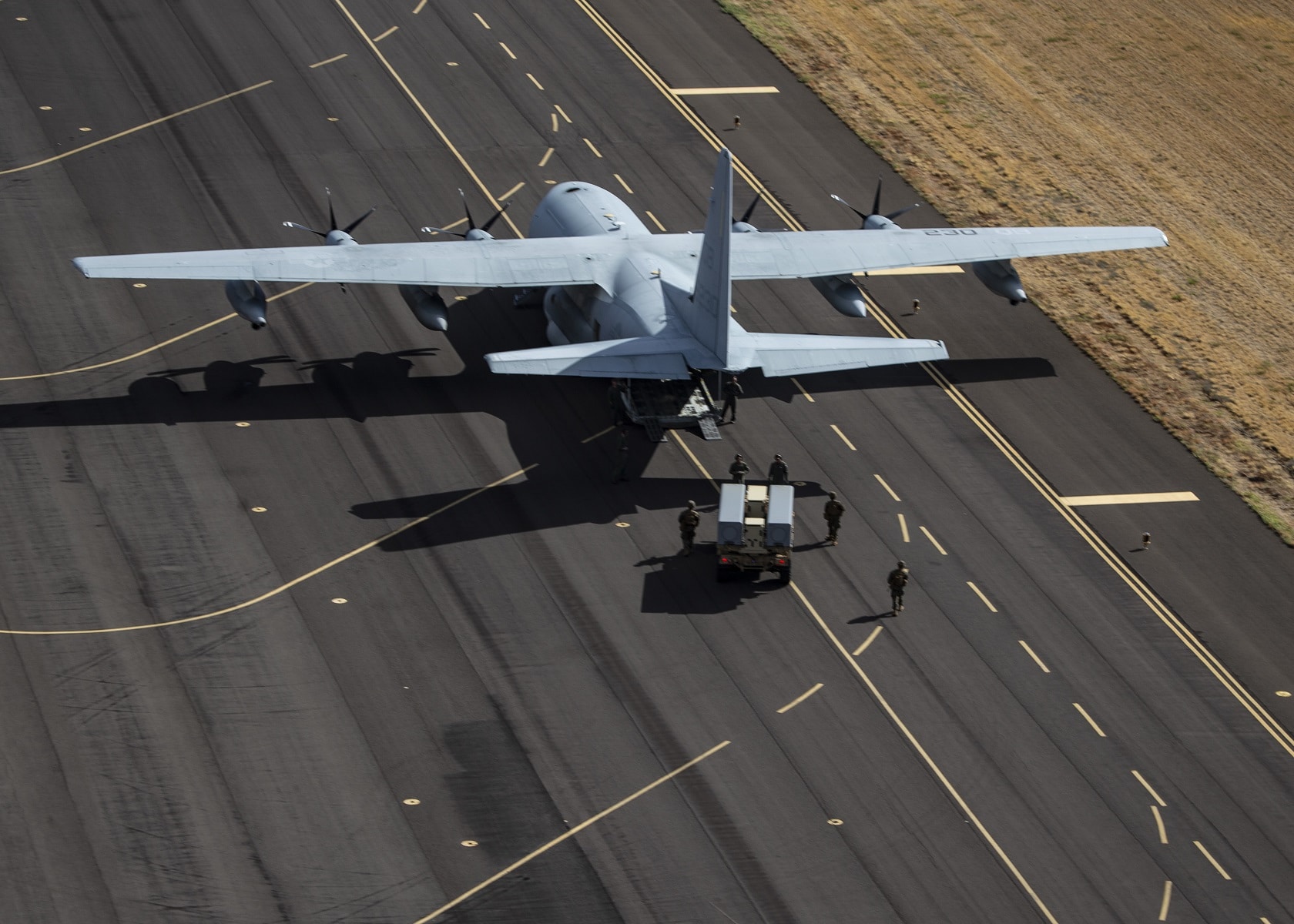
 www.navalnews.com
www.navalnews.com

USMC NMESIS and Naval Strike Missiles Logistics Explained - Naval News
The “tyranny of distance” problem in the United States Indo-Pacific Command (INDO-PACOM) region, dotted with numerous small islands, forms the basis of the U.S. Marine Corps’ (USMC) strategy of Expeditionary Advanced Base Operations (EABO) of establishing ad-hoc bases on land and sea and...
Last edited:
The USMC aren't using Tomahawks in that mission but the NSM, and potentially the LRASM, are the main tools. They still require targeting data but by using Link 16 that can be sent and received without detectable RF transmission. IMHO it is the type of capability that both the ADF & NZDF should be seriously considering.Interesting article on the US marines approach to expeditionary Himars, tomahawk and nsm batteries and the supporting logistics. Australia May face similar challenges and the USM solutions may offer short cuts. Wonder if NSM equipped Strike Master can fit in a Hercules?

USMC NMESIS and Naval Strike Missiles Logistics Explained - Naval News
The “tyranny of distance” problem in the United States Indo-Pacific Command (INDO-PACOM) region, dotted with numerous small islands, forms the basis of the U.S. Marine Corps’ (USMC) strategy of Expeditionary Advanced Base Operations (EABO) of establishing ad-hoc bases on land and sea and...www.navalnews.com
FormerDirtDart
Well-Known Member
The USMC will be acquiring 54 Tomahawk Block V missiles via a Navy contract signed back in May of this year. They are planned to used from trailer mounted launch systems derived from the Mk41 VLS. My understanding this falls under the Corps "Land Based Anti-Ship Missile (LBASM)" moniker. With a "B" not an "R", which may have led to your confusion.The USMC aren't using Tomahawks in that mission but the NSM, and potentially the LRASM, are the main tools. They still require targeting data but by using Link 16 that can be sent and received without detectable RF transmission. IMHO it is the type of capability that both the ADF & NZDF should be seriously considering.
The same Navy contract included 30 missiles for the US Army, to be utilized in a similar land based launch system. While the USN will get 70 missile for ship based VLS operations
Todjaeger
Potstirrer
Just a point of correction and clarification here. Link 16 transmissions are certainly detectable RF transmissions that range from 960 MHz to 1,215 Mhz, which is why certain aircraft were only kitted out to receive, but not transmit Link 16 initially.They still require targeting data but by using Link 16 that can be sent and received without detectable RF transmission. IMHO it is the type of capability that both the ADF & NZDF should be seriously considering.
The ability to detect something transmitting Link 16 data would be at least partially dependent on what was transmitting, the system being used to transmit, and what or to whom the transmissions were being made. If a directional antenna were used, then a hostile ESM system would need to be within the arc of transmission from the directional antenna. What would make detecting Link 16 or similar transmissions would likely involve directional antenna used for SATCOM, with the receiving satellites then distributing the Link 16 data to other assets.
As both the Bushmaster and the MSM will be in ADF service in other roles, the training and support will already be put in place.NSM on a ute............................Why not!
A useful addition to the ADF kit bag.
Does it need support and have limitations .............sure thing.
But what doesn't.
It's an investment worth looking at that provides another layer of deterrence and complexity for the bad guy.
In relative defence terms not that great an expense in capital and personnel.
A mobile land / air portable ASM system for a maritime nation occupying a massive island surrounded by vast oceans dotted with thousands of islands.
Should of had such a capability decades ago.
Cheers S
To put these two together will provide a useful capability at little additional cost.
As pointed out by others a great capability for the reserves.
A large amount of the training can be on simulators.
Redlands18
Well-Known Member
The other option is to develop the NSM as a Module that can be transported by the Man Trucks, with the Bushmaster the system is stuck on the truck. Cannot be removed other than b\y RAEME in a workshop.As both the Bushmaster and the MSM will be in ADF service in other roles, the training and support will already be put in place.
To put these two together will provide a useful capability at little additional cost.
As pointed out by others a great capability for the reserves.
A large amount of the training can be on simulators.

